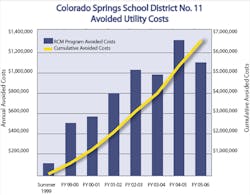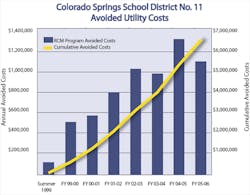5 Success Stories in Energy Management:
Colorado Springs School District No. 11
For Colorado Springs School District No. 11, one of Colorado’s largest school districts, proactive management of electricity (and other utilities) didn’t happen on a whim. The district’s annual electricity costs total approximately $2 million and are a significant portion of the operational budget for its 70 schools and additional support facilities. “Energy management is important to our school district primarily because it is a large part of our operational budget; also, we have the sense that we are stewards of the environment,” says the district’s Resource Conservation Management Program Coordinator Eric Anderson.
Recognizing the need (and potential) for energy reduction, the district began its Resource Conservation Management Program in the summer of 1999. Since that time, it has yielded tremendous savings and overwhelming support from a broad range of individuals in both the community and the district. School principals, building managers, security and IT professionals, community members, a representative from the district’s utility company, as well as others meet semi-annually as members of an Energy Advisory Committee. “The committee has offered us so much valuable feedback and positive direction, helping us avoid what would have been missteps in taking our program forward,” Anderson explains.
While it’s true that the district’s energy team did an excellent job of communicating the mission of the program through newsletters, meetings, presentations, and the Web, for staff members that were still unsure, an incentive plan doling out monetary rewards for utility conservation made participation too attractive to ignore. “We built an incentive system where we return some of the avoided utility cost money,” Anderson explains. To date, nearly $500,000 has been returned directly to the schools that demonstrate reduced energy consumption. “That has been a huge motivator over the last 7 to 8 years to get those folks to pay more attention and be very conscious of energy use and the way they’re [using] their buildings - from lighting to computers to kitchen equipment,” he says.
Through its efforts to consume less and conserve more, the district is receiving significantly smaller bills from its one-source water, natural gas, sewer, and electricity utility. “Through the end of our fiscal year, which ended June 30, 2006, we calculate a total gross avoided utility cost of $6.5 million since the start of our program in the summer of 1999,” says Anderson.
In the spirit of the age-old adage that says “you can’t manage what you don’t measure,” the district began by collecting data on utility use from the fiscal year of July 1, 1998, to June 30, 1999. By employing an accounting database for utility bills (created by its energy services company), the district was able to index energy use. Almost immediately, billing errors were discovered that resulted in a refund of approximately $100,000. This discovery (and the money it yielded) made getting buy-in for other energy-management projects easier.
The utility accounting database was created using Microsoft® Office Access software and has modules that calculate avoided costs (costs that would have been incurred if facilities continued operating as they did during FY1998-1999). The data offers Anderson and the district’s Energy Manager Thomas Fernandez the opportunity to compare current periods against the 1998-1999 baseline. The FY1998-1999 baseline for electric and gas use was 91.9 kBTU per square foot. The FY2005-2006 average was down to 75 kBTU per square foot, with some facilities operating at as low as 45 kBTU per square foot and others at as high as 130 kBTU per square foot. “The data really helps us pinpoint and identify opportunities where we can save energy,” says Anderson, “and, by doing that, save some cost, too.”
While the utility accounting database has been a vital part of the district’s success in conserving energy, it isn’t the only tool the team relies on. “The second tool we use is our energy-monitoring system; it’s part of our building automation or our direct digital building-controls system,” says Anderson. The metering software afforded Anderson and the rest of team the opportunity to scrutinize daily energy use and demand profiles for irregular trends, which have yielded many energy-saving opportunities.
“Near real-time, or real-time daily, hourly, or quarter-hourly data, really comes in handy,” Anderson says. Any anomalies are easily pinpointed and can be investigated immediately. A closer look at the data has led the district to examine whether schools’ mechanical systems are being operated according to optimum schedules; if equipment is in need of repair, recalibration, or replacement; and if faculty and student behavior can be modified to stop the waste of electricity (e.g. not turning off lights and excessive heating or air-conditioning).
With plans on the horizon to build two new elementary schools, the district is eager to implement some of the systems, technologies, and strategies proven to be effective in conserving electricity and gas. The goal is aggressive yet achievable, with a target set for each new facility to operate at only 25 kBTU per square foot. “We believe we can achieve that just by looking at innovative design,” Anderson adds.

